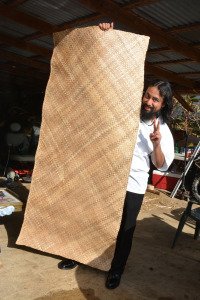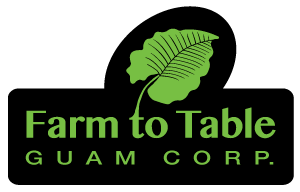
 As a non-profit that supports local value-added producers, it would be an understatement to say the staff at Farm to Table Guam were excited to meet James Bamba of Ginen Guåhan. Putting value into something that may not have much use, or any use at all, and creating artisanal products is ambitious to say the least. Still, it sets an excellent example for the community. Bamba not only sells his products, he offers workshops, presentations, and is involved with community outreach and education. He also works with and features other weavers’ work at local festivals. He currently has two apprentices, one who is 12 and learning to weave coconut leaves; the other who is in her thirties and is learning to weave åkgak (pandanus leaves).
As a non-profit that supports local value-added producers, it would be an understatement to say the staff at Farm to Table Guam were excited to meet James Bamba of Ginen Guåhan. Putting value into something that may not have much use, or any use at all, and creating artisanal products is ambitious to say the least. Still, it sets an excellent example for the community. Bamba not only sells his products, he offers workshops, presentations, and is involved with community outreach and education. He also works with and features other weavers’ work at local festivals. He currently has two apprentices, one who is 12 and learning to weave coconut leaves; the other who is in her thirties and is learning to weave åkgak (pandanus leaves).
 While preparing for The Farm to Table Market, we were introduced to Bamba and are proud to say we are now partners with Ginen Guåhan! At our soft opening in September, Bamba and his fellow weavers led a demonstration showing the community firsthand how he works his magic.
While preparing for The Farm to Table Market, we were introduced to Bamba and are proud to say we are now partners with Ginen Guåhan! At our soft opening in September, Bamba and his fellow weavers led a demonstration showing the community firsthand how he works his magic.
“My favorite item to weave is åkgak (pandanus leaf) baskets, such as kottot (betel nut basket), purses and cigarette cases. They’re much more challenging than coconut leaves.”
You can find Bamba and his products at the Farm to Table Market as well as various markets and events. Keep up to date by following Ginen Guåhan on Facebook, Twitter, Instagram, or visit his website, where you will also learn more abut James and his vision for Ginen Guåhan. Products are also sold at Sågan Kotturan Chamoru Cultural Center in Tamuning, Che’lu store in Chamorro Village, and Etsy.
[nivoslider slug=”ginen-guahan”]
Bamba was featured in Mariana’s Variety in July 2014. Read out the feature below written by Amber Word.
Dreamweaver
He’s got those hands; those big gentle hands akin to potters, woodworkers, and yes, weavers. Like many Chamorro men and women who still harbor the tradition, the practice of weaving hågon niyok (coconut leaves) is a practical talent. By gifting fans as a way to keep cool, or hats to protect themselves from the hot Guam sun, coconut leaf weaving is still in many ways alive.
James Bamba; however, is not your ordinary weaver, he specializes in weaving hågon åkgak (pandanus leaves). Traditionally, this intricate art was mastered by female weavers. To this day, as he travels from island to island to learn additional tools of the trade, he is met with a questioning eye. A Chamorro man? Learning to weave åkgak? But James sees what many refuse to look at. The art is fading fast.
In a world where value is associated with dollar signs, where capitalism oftentimes overrides culture. Many of the traditional arts are losing footing to their cheaper, mass-produced counterparts. Perceived convenience is partially to blame for this degradation of culture. In the past, people would wrap food in banana leaves and store it in hand-woven baskets, these days’ people head over to their neighborhood store to buy imported Tupperware. What many fail to realize is that “what you could make in 10 minutes of your time would take you three or four hours in a minimum wage job.” Amongst the younger generations especially, cultural identity is often questioned. What does it mean to be Chamorro? Is the language dying? Yet a cultural renaissance is at play. The recent resurgence in getting back to the local is re-kindling an interest in Chamorro traditional wisdom. James hopes that this also brings attention and value to the intricate art of åkgak weaving, luckily for Guam locals, he is active in the community, teaching this art to all those who express an interest.
Bamba’s paternal grandmother was a weaver, it was in his blood you might say. A child of Agaña Heights, he spent his days riding bikes, growing things and raising animals. It wasn’t until his grandmother fell ill that he began to view weaving in a whole new light. His Uncle Pedro was sitting with coconut leaves in hand. Over. Under. Over. Under. But why? The look on his grandmother’s face as she was presented with the basket, now brimming with hand-picked fruit, answered that question for him and gave rise to his passion for weaving. He was only sixteen.
Bamba was taught to weave in the traditional way. Sit. Listen. Don’t talk. See it. Know it. Then do it. From niyok he moved on to the firmer, longer lasting, more intricate åkgak leaves. Those early days were full of cuts from the sharp thorns of the leaves and spine, but he persevered. Grateful for finding his passion and finding a way to carry on a cultural tradition that is vital for Chamorro cultural preservation.
A student in practice a linguist by trade, these days he spends his time in the study hall – learning and teaching his way through the UOG’s Secondary Education, Chamorro Language program. Perhaps it is here that he learns a hands-on approach to learning. As a teacher, he uses a mixture of both the old Chamorro traditional approach as well as hands-on methods. He tries to modify his teaching style according to the way the student is most receptive.
Bamba is a much needed bridge in the cultural shift transforming our world, he holds strong to traditional methods and cultural intricacies while adapting previously gender-specific norms and difficult-to-digest teaching methods.
To contact James for weaving lessons or presentations, contact him via his website, www.ginen-guahan.com. You can also view his wares today at the 11th Annual Chamorro Dance Competition and Festival at the University of Guam Fieldhouse.
